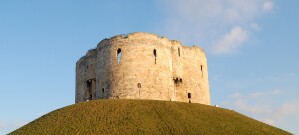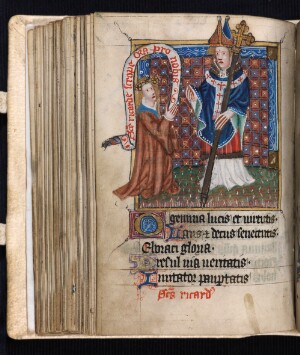York in Neuton's Time
Sarah Rees Jones (University of York)
These two decades were a tumultuous period in the history of York. The period of John Neuton's residence in the city could certainly be described as 'exciting times' and ones that were immensely important in both bringing the cultural life of the city to its full fruition and leaving some major legacies to the future. As the county town of the exceptionally large Northern county of Yorkshire, the city of York around 1400 was both a vibrant city and a key centre for royal administration.
York's population probably stood at something in the region of fourteen to fifteen thousand. This was a decline of about one third from the city's maximum population about one century earlier, but was still nearly twice the size that it would shrink to by the sixteenth century. Population decline was the consequence of repeated epidemics of the plague since 1349 but also of structural shifts in the regional economy: the growth of the Yorkshire cloth industry, for example, benefitted other smaller towns of the region at least as much as York, while the growth of Hull as a port undermined some of York's functions as a centre of trade. On top of this, the changing focus of royal government after 1337, towards war with France rather than Scotland, removed from York some of the business from royal government offices which had boosted its economy earlier in the fourteenth century. Indeed the 1390s were probably something of a turning point. Evidence suggests that this was the first decade in which demand for housing began to decline, even if the property rental market was not yet as weak as it would become a few decades later when many houses (especially smaller houses) were abandoned altogether.
The changing economic fortunes of the city probably lay behind some of the political events in those two decades. The 1390s began with King Richard II befriending York, although only as part of an attempt to punish the City of London, with whom he had fallen out. In 1392 Richard moved the centre of his government from London to York and stayed for ten days. His presence, which coincided with Holy Week, was attended with great ceremony, including a revival of the royal tradition of giving out pennies to the poor in York Minster on Maundy Thursday. He stayed again, for two weeks, in 1396. The visits were followed by the granting of new charters of liberties which greatly extended the autonomy of civic government and diminished the authority not only of the sheriffs of Yorkshire but also other local landlords who claimed jurisdiction within the city, such as the Dean and Chapter of York Minster (Fig. 1). Richard's friendship with the city did not last however. The tyranny of his later years was felt locally when several leading York merchants were imprisoned for refusing (or being unable) to lend him extortionate loans in 1396. In 1399 it is not surprising that the city of York turned its support to Henry Bolingbroke, Duke of Lancaster (soon to become Henry IV). Bolingbroke landed in Ravenser Odd in east Yorkshire and the city of York immediately lent him £2000 in support of his campaign against Richard II.
Despite their support in winning him the throne, relationships between the city and Henry IV during his reign were no better, and in some ways were much worse than they had been under Richard II. The city struggled to persuade Henry IV to repay his loan and at least some local merchants continued to be convinced that their difficulties were the responsibility of royal government. In 1405 some York merchants joined a major northern rebellion against royal government led by the Percy Earl of Northumberland and Archbishop Richard Scrope. Scrope was tried for treason, condemned and executed in the fields of Clementhorpe. A few York men suffered a similar fate, while others supported the crown. The precise reasons why Scrope joined the rebellion remain enigmatic, but a manifesto circulated after his execution suggested that he was critical of royal government for its excessive taxation of local merchants. Whatever the reason for his rebellion, Scrope's martyrdom substantially undermined the authority of Henry IV in the eyes of both church and people. Locally Richard Scrope was venerated as a saint, and Neuton may have played some part in promoting his cult. Henry IV was condemned by the pope and lived under the cloud of his actions against the prelate for the rest of his life. His son, the future Henry V, led the process of reconciliation which included rehabilitation of Scrope's memory. An early plan to found a new Brigittine house in York in contrition for the execution of the archbishop came to nothing (the house was founded at Syon instead). However it is likely that the York guild of Corpus Christi, guardian of some of the saint's relics, and the cult of an earlier archbishop, St William of York in the Minster, both flourished as a result of their association with the early popularity for St Richard Scrope (Fig. 2).
The tumultuous politics of the two decades divided families and were closely associated with ongoing internal conflicts over the control of civic government. Perhaps because of this disorder the decades around 1390 were also decades of reform of many city institutions and the foundation of new ones. The fraternities of Holy Cross, of Jesus and Mary, St George, St Christopher and St John the Baptist were all founded before 1400. Although we lack foundation dates the guild of Corpus Christi is first mentioned in 1408, the Holy Trinity Guild of the Mercers in 1410, the St Anthony Guild in 1415 and the Holy Trinity Guild in the Dominican Friary in 1418. The popularity of new religious didactic literature in the region is reflected in stained glass and in the lists of books owned by York citizens, whose reading tastes were both more cosmopolitan and more diverse than has often been supposed.
In the Minster the college of the Vicars Choral (the minor clergy who supported daily services in the cathedral church) was also given new statutes, new conventual buildings and new endowments. The famous city mystery plays (first recorded in 1376) were slowly reorganised and increasingly brought under civic control, with a list of the plays being produced by the civic authorities in 1415.
Throughout these two decades the community of the Minster was at the heart of York affairs. Many of the Minster's minor clergy came from local families and were certainly caught up in the Scrope revolt, while both before and after 1405 it is apparent that even the most senior clergy were figures of real influence in the city and the region. Minster and city, clergy and laity were united in their experience of economic pressures and political events, and equally caught up in the new religious devotions of the time.
Further Reading
D. J. F. Crouch, Piety, Fraternity and Power: Religious Gilds in Late Medieval Yorkshire, 1389-1547 (Woodbridge: York Medieval Press, 2000).
A. Dyer, 'Appendix: Ranking Lists of English Medieval Towns', in The Cambridge Urban History of Britain, ed. by D. M. Palliser, 3 vols (Cambridge: Cambridge University Press, 2000), I, pp. 747-755.
T. French, York Minster: The Great East Window, Corpus Vitrearum Medii Aevi (Great Britain) Summary Catalogue 2 (Oxford: Oxford University Press, 1995), pp. 5-6.
K. Giles, An Archaeology of Social Identity: Guildhalls in York, c. 1350-1630, British Archaeological Reports, no. 315 (Oxford: Archaeopress, 2000).
P. J. P. Goldberg, Women, Work, and Life Cycle in a Medieval Economy: Women in York and Yorkshire, c. 1300-1520 (Oxford: Oxford University Press, 1992).
Richard Scrope: Archbishop, Rebel, Martyr, ed. by P. J. P. Goldberg (Donington: Shaun Tyas, 2007).
P. M. King, The York Mystery Cycle and the Worship of the City, Westfield Medieval Studies I (Woodbridge: D. S. Brewer, 2006).
C. D. Liddy, War, Politics and Finance in Late Medieval English Towns: Bristol, York and the Crown, 1350–1400 (Woodbridge: Royal Historical Society, 2005).
E. Miller, 'Medieval York', in A History of the County of York: The City of York, ed. by P. M. Tillot, Victoria History of the Counties of England (Oxford: Oxford University Press, 1961), pp. 25-116.
D. M. Palliser, Medieval York, 600–1540 (Oxford: Oxford University Press, 2014).
The Government of Medieval York: Essays in Commemoration of the 1396 Royal Charter, ed. by S. Rees Jones, Borthwick Studies in History, 3 (York: University of York, 1997), pp. 88-107.
S. Rees Jones, 'God and Mammon: The Role of the City Estate of the Vicars Choral in the Religious Life of York Minster', in Vicars Choral at English Cathedrals: Cantate Domino: History, Architecture and Archaeology, ed. by R. A. Hall and D. Stocker (Oxford: Oxbow Books, 2005), pp. 192-199.
S. Rees Jones and F. Riddy, 'The Bolton Hours of York: Female Domestic Piety and the Public Sphere' in Household, Women, and Christianities in Late Antiquity and the Middle Ages, ed. by A. B. Mulder-Bakker and J. Wogan-Browne (Turnhout: Brepols, 2005), pp. 215-260.

